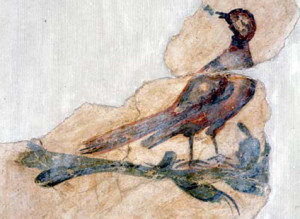
The Mosaic and Wall Painting Collection of the Aquincum Museum contains the remains of interior and exterior decorative surfaces from buildings discovered in Aquincum.
The collection, established in the early 1990s, contains floor mosaics, terrazzo fragments, wall painting sections, marble slabs from exterior walls, as well as over 1600 boxes of wall painting and stucco fragments.
Among the decorations of the mosaics in the collection – made of small, black and white as well as colourful tesserae and dated to the 2nd and 3rd centuries – we can find both geometrical patterns and figural scenes.
One of the collection’s highlights is the colourful mosaic from a villa in the Military Town depicting Hercules and Deianira. The central piece featuring the mythological scene consists of nearly 60,000 tiny tesserae, with 9-10 pieces per 1 cm2.
Another key Aquincum mosaic comes from the Civil Town. The highly fragmented mosaic presumably depicts the tying of Dirce to a bull, like the Farnese Bull sculpture exhibited at the Naples National Archaeological Museum.
Items in the wall painting collection date to the period between the 2nd and 4th centuries. Among them we find painted and stucco-covered wall and ceiling fragments, as well as stucco friezes depicting plants and stylised hunting scenes (with fleeing animals). Wall paintings fragments in the collection include complex designs with mythological scenes, rich in colours and detail, which required significant skills, as well as simpler solutions with stripes and wide bands or white plaster.
Two ceiling decorations with geometric patterns from the collection are on display in the museum. The one consisting of octagons comes from the governor’s palace, while the other – with circles and curved hexagons – comes from the Csúcshegy villa.
One of the most important paintings in the collection is a rare Mithras cult image, found in legionary fortress. At the centre is the famous scene of Mithras defeating the bull; and around it are further depictions of the main stages of Mithras’ life.
Further highlights of the collection are the finds from a richly-decorated villa from the Military Town excavated near Búvár Street and Folyamőr Street. These include painted plinths with storks and marble imitations, stucco fragments with Dionysian scenes, as well as mosaic floors with geometric patterns and animal depictions.
Some of the mosaics can be seen on-site (the Hercules villa, Thermae Maiores, Civil Town [the ‘wrestlers’ mosaic]). A number of other mosaics are exhibited at the Aquincum Museum (four mosaic floors from the Governor’s Palace and a mosaic with coffered decoration from the villa near Búvár and Folyamőr Streets). The rest are held in the museum’s storage facilities.
The curators of the collection: Dr. Anita Kirchhof and Nikoletta Varga


